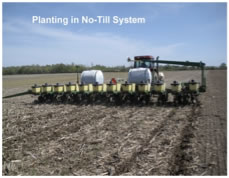Competency Area 3: Tillage Systems
PO 13. Describe the advantages and limitations of plow, chisel, reduced and no-tillage systems for corn and alfalfa production in the Northeast.
Advantages of a plow tillage system
Plow tillage can improve soil physical conditions (aeration, tilth, less soil resistance, lowers soil bulk density, etc.) for a 1-2 month period of time. Plow tillage also serves as a weed control method and may reduce insect and pathogen problems. It helps to incorporates fertilizers and chemicals, as well as incorporating residue so the soil warms up faster. Plow tillage may also result in a better seedbed for stand establishment of corn.
Disadvantages of a plow tillage system
Plow tillage is costly tillage, increasing expenses for labor, fuel, and machinery. Plow tillage can delay planting of corn and soybeans. It can result in soil compaction or plowpans and can result in more soil erosion. Plow tillage also prevents soil organic matter from building up in the soil.
Advantages of chisel or reduced tillage systems
Chisel tillage or reduced tillage may reduce soil erosion. It can aid in the conservation of soil moisture on droughty soils. Reduced tillage also saves time compared to plow tillage, as well as reducing fuel, and machinery costs. Reduced tillage usually leaves more than 30% residue on the soil surface resulting in conservation compliance.
Disadvantages of chisel or reduced tillage systems
Chisel tillage can reduce soil temperatures so corn and soybeans get off to a slower start. It can also reduce crop stand because the seedbed may be rougher. Pest pressure can be increased, especially for weeds.
Quick Links
- Competency Area 1: Crop Adaptation
- Competency Area 2: Crop Staging, Growth, and Development
- Competency Area 3: Tillage Systems
- Competency Area 4: Seeding Factors
- Competency Area 5: Seeding Rates and Row Spacing
- Competency Area 6: Considerations in Replanting Decisions
- Competency Area 7: Forage Harvesting Factors
- Competency Area 8: Cropping Systems

